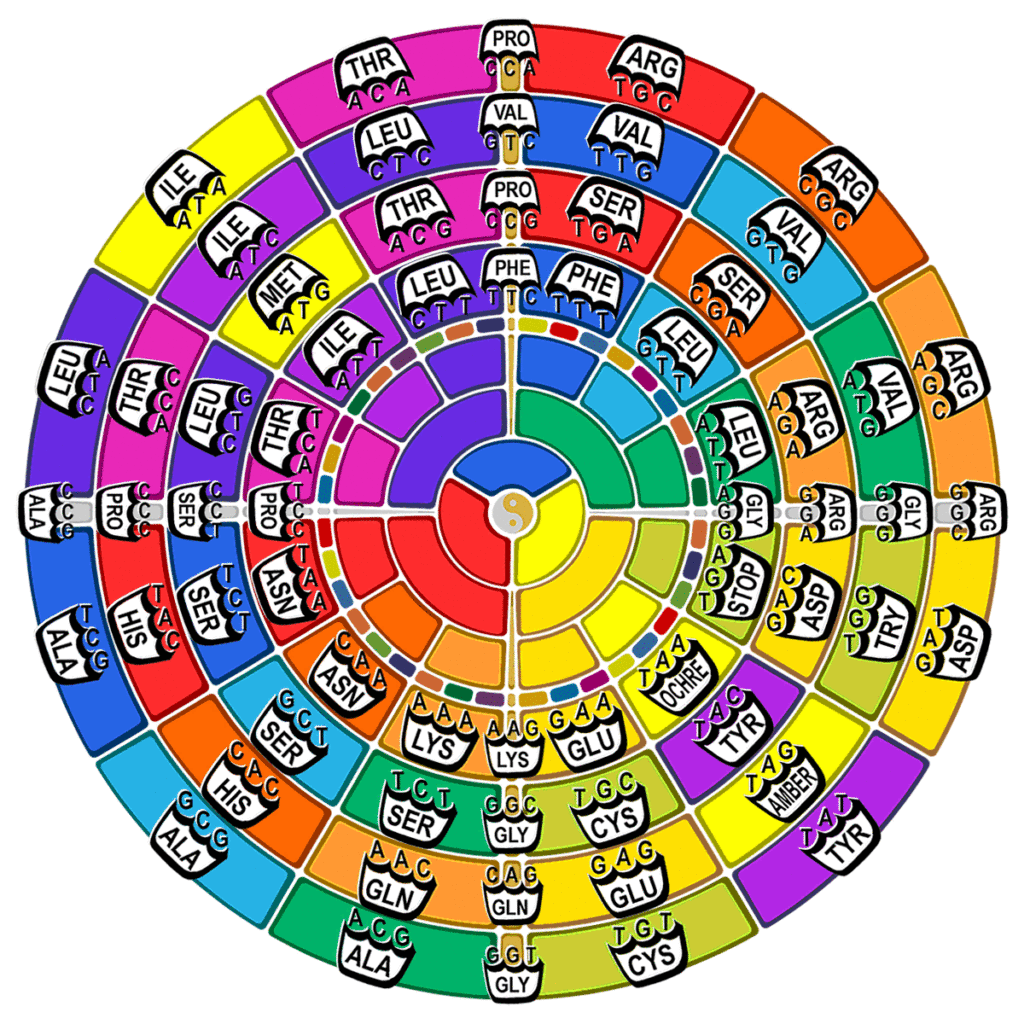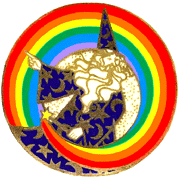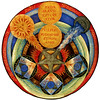DNA Code and Amino Acids
Universal Life Code as placed upon the World Clock
These 21 amino acids provide the fundamental building blocks from which all human life is constructed. The entire DNA is written using a code of only 4 letters, namely T-Thymine, A-Adenine, C-Cytosine and G-Guanine. First, DNA is transcribed into long strands of Messenger RNA by using the above four letters in groups of three, and these “Triplet Codons” contain the copied code. The sequence of these triplet groups represent chains specific amino acids found in various enzymes and proteins.
The Amino Acids - Building Blocks of All Life
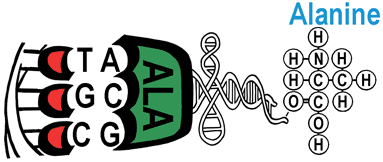 ALA – Alanine: An aliphatic molecule, made from a short linear chain of carbon atoms. Although Non Polar, meaning not water soluble and essentially hydrophobic, it is less strictly segregated from water due to it’s smaller size. Used in maintaining blood glucose levels by converting carbohydrates stored in liver and muscle tissue into glucose needed by the body to satisfy its energy needs. Also used as a food seasoning.
ALA – Alanine: An aliphatic molecule, made from a short linear chain of carbon atoms. Although Non Polar, meaning not water soluble and essentially hydrophobic, it is less strictly segregated from water due to it’s smaller size. Used in maintaining blood glucose levels by converting carbohydrates stored in liver and muscle tissue into glucose needed by the body to satisfy its energy needs. Also used as a food seasoning.
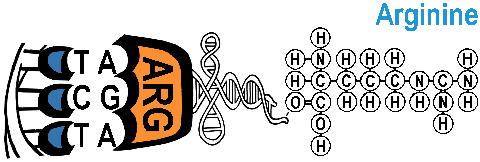 ARG – Arginine: An aliphatic molecule, made up of a long linear chain of atoms that are mostly carbon. Polar, water soluble molecule with a hydrophilic side chain, it also carries a positive electrical charge. Being strongly hydrophilic, it is confined only to hydrated areas. Stimulates the immune system, promotes wound healing, and blocks formation of tumors. In the Anterior Pituitary gland, causes release of growth hormones. Increases spermatogenesis in sex glands. Also promotes detoxification of ammonia, and is involved in liver regeneration.
ARG – Arginine: An aliphatic molecule, made up of a long linear chain of atoms that are mostly carbon. Polar, water soluble molecule with a hydrophilic side chain, it also carries a positive electrical charge. Being strongly hydrophilic, it is confined only to hydrated areas. Stimulates the immune system, promotes wound healing, and blocks formation of tumors. In the Anterior Pituitary gland, causes release of growth hormones. Increases spermatogenesis in sex glands. Also promotes detoxification of ammonia, and is involved in liver regeneration.
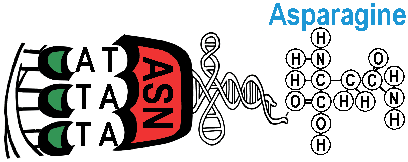 ASN – Asparagine: Polar, meaning water soluble molecule with a hydrophilic side chain, but here is not carrying an electrical charge. An aliphatic molecule, made from a linear chain of carbon atoms. While possessing a hydrophilic character, being electrically neutral it can also be accommodated in hydrophobic regions. Participates in the metabolic control of cells functions in the brain and nervous system, thus used in treatment of brain and nervous system disorders.
ASN – Asparagine: Polar, meaning water soluble molecule with a hydrophilic side chain, but here is not carrying an electrical charge. An aliphatic molecule, made from a linear chain of carbon atoms. While possessing a hydrophilic character, being electrically neutral it can also be accommodated in hydrophobic regions. Participates in the metabolic control of cells functions in the brain and nervous system, thus used in treatment of brain and nervous system disorders.
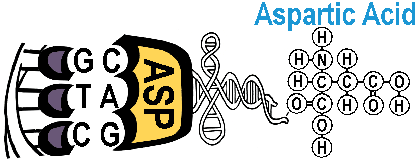 ASP – Aspartic Acid: This Polar, meaning water soluble molecule with a hydrophilic side chain, and in this instance, negatively charged. Being an aliphatic molecule, it is made up from a linear chain of carbon atoms. Nitrogen derived from Aspartic Acid is used to form ribonucleotides, precursors to RNA and DNA. Aids in the disposal and detoxification of ammonia in the body. Also increases overall resistance to fatigue.
ASP – Aspartic Acid: This Polar, meaning water soluble molecule with a hydrophilic side chain, and in this instance, negatively charged. Being an aliphatic molecule, it is made up from a linear chain of carbon atoms. Nitrogen derived from Aspartic Acid is used to form ribonucleotides, precursors to RNA and DNA. Aids in the disposal and detoxification of ammonia in the body. Also increases overall resistance to fatigue.
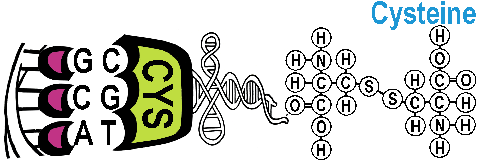 CYS – Cysteine: This uncharged, Polar molecule, has a water soluble has a hydrophilic side chain. An aliphatic molecule, being made up of a linear chain of atoms. Cysteine is normally found joined to another Cysteine molecule, connected through an inherently nonpolar (not water soluble) disulfide bridge, as shown in this example. While having a hydrophilic character, being electrically neutral allows it to also be accommodated in hydrophobic regions. Used to stimulate white blood cell activity in the immune system. Essential for the formation of skin, and promotes healing from cuts and burns. Effective antioxidant and scavenger of free radicals.
CYS – Cysteine: This uncharged, Polar molecule, has a water soluble has a hydrophilic side chain. An aliphatic molecule, being made up of a linear chain of atoms. Cysteine is normally found joined to another Cysteine molecule, connected through an inherently nonpolar (not water soluble) disulfide bridge, as shown in this example. While having a hydrophilic character, being electrically neutral allows it to also be accommodated in hydrophobic regions. Used to stimulate white blood cell activity in the immune system. Essential for the formation of skin, and promotes healing from cuts and burns. Effective antioxidant and scavenger of free radicals.
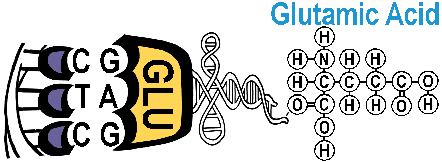 GLU – Glutamic Acid: Also known as glutamate, this Polar molecule has a water soluble, hydrophilic side chain, which carries a negative charge. This aliphatic molecule is made from a linear chain of carbon atoms. Being strongly hydrophilic, is thus confined to only hydrated areas. Approximately 50% of the amino acid composition in the brain is represented by GLU and it’s derivatives. Used to transport potassium across the blood brain barrier. This amino acid acts as an excitatory neurotransmitter in the central nervous system, so is essentially fuel for the brain. Also found in stomach.
GLU – Glutamic Acid: Also known as glutamate, this Polar molecule has a water soluble, hydrophilic side chain, which carries a negative charge. This aliphatic molecule is made from a linear chain of carbon atoms. Being strongly hydrophilic, is thus confined to only hydrated areas. Approximately 50% of the amino acid composition in the brain is represented by GLU and it’s derivatives. Used to transport potassium across the blood brain barrier. This amino acid acts as an excitatory neurotransmitter in the central nervous system, so is essentially fuel for the brain. Also found in stomach.
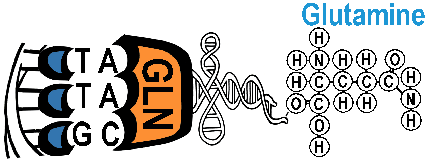 GLN – Glutamine: Polar molecule with a water soluble, hydrophilic side chain. This uncharged, aliphatic molecule is made up of carbon atoms forming a linear chain. While having a clearly hydrophilic character, being electrically neutral allows it to be accommodated in hydrophobic regions as well. Readily passing through the blood brain barrier, it picks up ammonia in the central nervous system and delivers it to kidneys for deanimation. Used to protect against the poisonous effects of alcohol, and in the treatment of schizophrenia and senility. Also found in the intestinal tract.
GLN – Glutamine: Polar molecule with a water soluble, hydrophilic side chain. This uncharged, aliphatic molecule is made up of carbon atoms forming a linear chain. While having a clearly hydrophilic character, being electrically neutral allows it to be accommodated in hydrophobic regions as well. Readily passing through the blood brain barrier, it picks up ammonia in the central nervous system and delivers it to kidneys for deanimation. Used to protect against the poisonous effects of alcohol, and in the treatment of schizophrenia and senility. Also found in the intestinal tract.
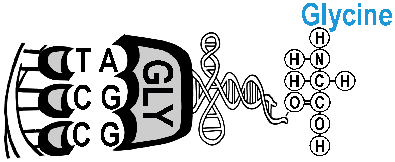 GLY – Glycine: This simplest of all the amino acids is a Non-Polar molecule and is thus not water soluble. While essentially hydrophobic, is found to be less strictly segregated from water due to it’s small size. Helps in the formation of the purine skeleton utilized in constructing RNA and DNA strands. Inhibitory neurotransmitter in the central nervous system. Stimulates the release of growth hormone, and aids in synthesis of hemoglobin. Used as food additive for a sweeter taste, is also effective for hyperacidity in the stomach (used in antacids).
GLY – Glycine: This simplest of all the amino acids is a Non-Polar molecule and is thus not water soluble. While essentially hydrophobic, is found to be less strictly segregated from water due to it’s small size. Helps in the formation of the purine skeleton utilized in constructing RNA and DNA strands. Inhibitory neurotransmitter in the central nervous system. Stimulates the release of growth hormone, and aids in synthesis of hemoglobin. Used as food additive for a sweeter taste, is also effective for hyperacidity in the stomach (used in antacids).
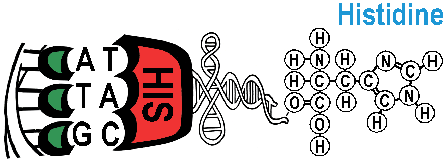 HIS – Histidine: A Polar molecule with a water soluble, hydrophilic side chain. Although normally holding a Positive charge, only about half are actually charged at any given moment. While an organic compound, this Heterocyclic molecule has elements in it’s ring other than carbon. Strongly hydrophilic and confined to only hydrated areas. Important in production of red and white blood cells, is abundant in hemoglobin, also the oxygen carrying pigment of red blood cells. Effective in treating allergic diseases. Helps remove heavy metals from tissues by chelation to trace minerals.
HIS – Histidine: A Polar molecule with a water soluble, hydrophilic side chain. Although normally holding a Positive charge, only about half are actually charged at any given moment. While an organic compound, this Heterocyclic molecule has elements in it’s ring other than carbon. Strongly hydrophilic and confined to only hydrated areas. Important in production of red and white blood cells, is abundant in hemoglobin, also the oxygen carrying pigment of red blood cells. Effective in treating allergic diseases. Helps remove heavy metals from tissues by chelation to trace minerals.
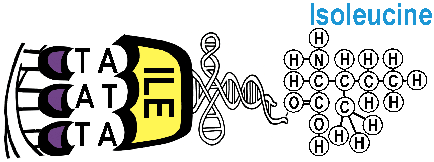 ILE – Isoleucine: This is an Aliphatic molecule, made up of a long linear chain of carbon atoms. It is Non Polar, and thus not water soluble. A very hydrophobic amino acid, tends to be buried in regions from which water is excluded. It is found in high concentrations in muscle tissue. Since the only source is through dietary intake, it must be kept in balance proportion with other amino acids, or nutritional conflicts may occur.
ILE – Isoleucine: This is an Aliphatic molecule, made up of a long linear chain of carbon atoms. It is Non Polar, and thus not water soluble. A very hydrophobic amino acid, tends to be buried in regions from which water is excluded. It is found in high concentrations in muscle tissue. Since the only source is through dietary intake, it must be kept in balance proportion with other amino acids, or nutritional conflicts may occur.
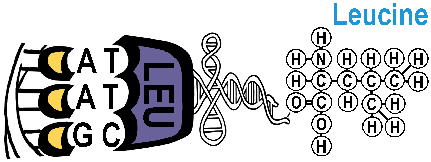 LEU – Leucine: Being a Non-Polar amino acid, this molecule is not water soluble. It is an aliphatic molecule made up from a linear chain of carbon atoms. Tends to be found buried in regions from which water is excluded due to being very hydrophobic. Must be kept in balance with other amino acids through dietary intake, or nutritional conflicts may occur. Useful in lowering blood sugar levels. It is found in high concentrations in muscle tissue, and promotes wound healing of skin and bone.
LEU – Leucine: Being a Non-Polar amino acid, this molecule is not water soluble. It is an aliphatic molecule made up from a linear chain of carbon atoms. Tends to be found buried in regions from which water is excluded due to being very hydrophobic. Must be kept in balance with other amino acids through dietary intake, or nutritional conflicts may occur. Useful in lowering blood sugar levels. It is found in high concentrations in muscle tissue, and promotes wound healing of skin and bone.
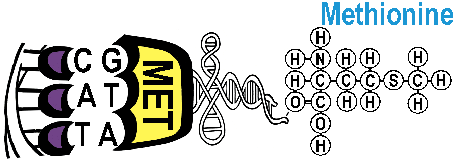 MET – Methionine is a Non Polar molecule, meaning not water soluble, and essentially hydrophobic. Being a hydrophobic amino acid, it tends to be found buried within regions from which water is almost entirely excluded. This aliphatic linear chain is mostly made up of carbon, while also containing a single atom of Sulfur. As principle source of daily sulfur from which the body replenishes, must be carefully regulated with other amino acids, or nutritional imbalances could occur. Functioning as an antioxidant, a free radical deactivator, and neutralizer of toxins, it helps to guard against disorders of skin and nails, prevents hair loss, and curbs accumulations of fat in the liver. Still more importantly, this AUG triplet codon serves as initiator site for all mRNA encoding, and thus is located at the ‘START’ of every protein translation sequence.
MET – Methionine is a Non Polar molecule, meaning not water soluble, and essentially hydrophobic. Being a hydrophobic amino acid, it tends to be found buried within regions from which water is almost entirely excluded. This aliphatic linear chain is mostly made up of carbon, while also containing a single atom of Sulfur. As principle source of daily sulfur from which the body replenishes, must be carefully regulated with other amino acids, or nutritional imbalances could occur. Functioning as an antioxidant, a free radical deactivator, and neutralizer of toxins, it helps to guard against disorders of skin and nails, prevents hair loss, and curbs accumulations of fat in the liver. Still more importantly, this AUG triplet codon serves as initiator site for all mRNA encoding, and thus is located at the ‘START’ of every protein translation sequence.
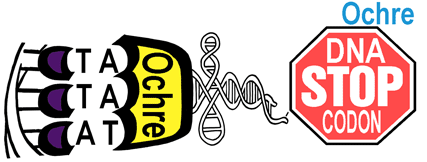 Within the genetic code, there are a few mRNA triplet nucleotides which are referred to as STOP, or Termination Codons. Most mRNA codons will sequence for specific Amino Acids, which then are assembled into long polypeptide strands. When a termination release factor recognizes a STOP codon has been reached, the process of RNA transcription abruptly ends. Binding a water molecule at the end of the sequence, the completed amino acid chain floats off within the cell, and folds itself into a complex protein. The first of these “nonsense mutations” triplets discovered was UAG, originally named Amber after researcher Harris Bernstein, whose last name translated as “amber” in German. So later, when the second STOP codon was found, it too was given a color name matching the Amber mutants, then on referred to as UAA “Ochre” mutants. The third and final STOP codon in the genetic code is Opal, found due to its own particular nonsense mutations corresponding to the “UGA” nucleotide triplet.
Within the genetic code, there are a few mRNA triplet nucleotides which are referred to as STOP, or Termination Codons. Most mRNA codons will sequence for specific Amino Acids, which then are assembled into long polypeptide strands. When a termination release factor recognizes a STOP codon has been reached, the process of RNA transcription abruptly ends. Binding a water molecule at the end of the sequence, the completed amino acid chain floats off within the cell, and folds itself into a complex protein. The first of these “nonsense mutations” triplets discovered was UAG, originally named Amber after researcher Harris Bernstein, whose last name translated as “amber” in German. So later, when the second STOP codon was found, it too was given a color name matching the Amber mutants, then on referred to as UAA “Ochre” mutants. The third and final STOP codon in the genetic code is Opal, found due to its own particular nonsense mutations corresponding to the “UGA” nucleotide triplet.
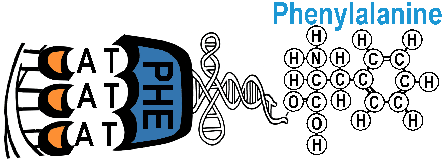 PHE – Phenylalanine: Related to other organic groups containing rings of carbon atoms, this Aromatic amino acid has a side chain derived from benzene by removal of one hydrogen atom. Tending to be buried in regions where water is excluded, this Non Polar amino acid is not water soluble, and is a very hydrophobic. Used by the brain as a natural precursor to the manufacture of norepinephrine and other neurotransmitters, it enhances learning, alertness and memory. Also used in the treatment of depression, and the ‘D’ form Phenylalanine acts as a pain killer. Nutritional conflicts may occur unless kept in balance with other amino acids through dietary intake.
PHE – Phenylalanine: Related to other organic groups containing rings of carbon atoms, this Aromatic amino acid has a side chain derived from benzene by removal of one hydrogen atom. Tending to be buried in regions where water is excluded, this Non Polar amino acid is not water soluble, and is a very hydrophobic. Used by the brain as a natural precursor to the manufacture of norepinephrine and other neurotransmitters, it enhances learning, alertness and memory. Also used in the treatment of depression, and the ‘D’ form Phenylalanine acts as a pain killer. Nutritional conflicts may occur unless kept in balance with other amino acids through dietary intake.
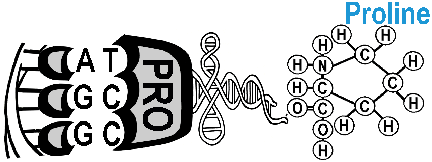 PRO – Proline: Similar to other organic compounds forming rings of carbon atoms, this Heterocyclic amino acid contains a single atom of nitrogen within that ring. A Non Polar, non water soluble and essentially hydrophobic molecule, yet less strictly segregated from water due to the rigidity imposed by the cyclization of the R group with the primary amino group. Major constituent of collagen, the main fibrous protein found in bone, cartilage and other connective tissue. Used in the maintenance and repair of joints and tendons.
PRO – Proline: Similar to other organic compounds forming rings of carbon atoms, this Heterocyclic amino acid contains a single atom of nitrogen within that ring. A Non Polar, non water soluble and essentially hydrophobic molecule, yet less strictly segregated from water due to the rigidity imposed by the cyclization of the R group with the primary amino group. Major constituent of collagen, the main fibrous protein found in bone, cartilage and other connective tissue. Used in the maintenance and repair of joints and tendons.
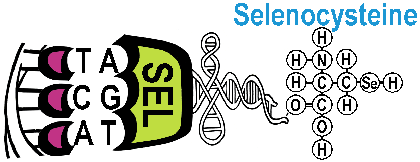 Most proteins which incorporate Selenocysteine are redox enzymes, including glutation peroxidases, thioredoxin reductases, formate dehydrogenases, glycine reductases, as well as some hydrogenases. While Selenoproteins are common throughout all three domains of life, only 25 such proteins are know to exist in our human genome. The inclusion of Selenocysteine as an amino acid is also an example of codon triplet redefinition, since UGA previously was only associated with the STOP codon Opal. Corresponding “nonsense mutations” identified Opal as a polypeptide sequence terminator, making it the third and last STOP codon discovered in the genetic code. When termination release factors reach a STOP codon, transcription of mRNA abruptly ends, while also binding a single water molecule at the end of the sequence. Once completed, these amino acid chains floats off within the cell, folding themselves into complex proteins.
Most proteins which incorporate Selenocysteine are redox enzymes, including glutation peroxidases, thioredoxin reductases, formate dehydrogenases, glycine reductases, as well as some hydrogenases. While Selenoproteins are common throughout all three domains of life, only 25 such proteins are know to exist in our human genome. The inclusion of Selenocysteine as an amino acid is also an example of codon triplet redefinition, since UGA previously was only associated with the STOP codon Opal. Corresponding “nonsense mutations” identified Opal as a polypeptide sequence terminator, making it the third and last STOP codon discovered in the genetic code. When termination release factors reach a STOP codon, transcription of mRNA abruptly ends, while also binding a single water molecule at the end of the sequence. Once completed, these amino acid chains floats off within the cell, folding themselves into complex proteins.
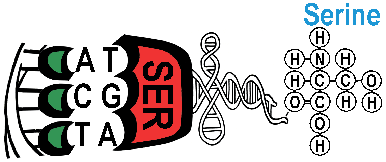 SER – Serine: This Hydroxyl containing, water soluble Polar amino acid has a hydrophilic side chain, while carrying no electrical charge. An aliphatic molecule, it’s made from a short chain of carbon atoms. Although having a hydrophilic character, being electrically neutral also allows it to be accommodated in hydrophobic regions. Assist in the manufacture of the organic acid Creatine, found in blood, while also present within muscle and brain tissue as an energy source for muscle contraction. Participant in purine, pyrimidine and porphyrin biosynthesis. Also found as a natural moisturizing agent sometimes used in various cosmetic products.
SER – Serine: This Hydroxyl containing, water soluble Polar amino acid has a hydrophilic side chain, while carrying no electrical charge. An aliphatic molecule, it’s made from a short chain of carbon atoms. Although having a hydrophilic character, being electrically neutral also allows it to be accommodated in hydrophobic regions. Assist in the manufacture of the organic acid Creatine, found in blood, while also present within muscle and brain tissue as an energy source for muscle contraction. Participant in purine, pyrimidine and porphyrin biosynthesis. Also found as a natural moisturizing agent sometimes used in various cosmetic products.
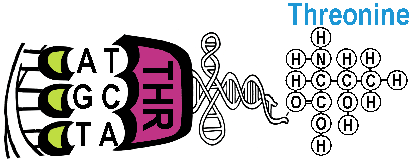 THR – Threonine: This Hydroxyl containing molecule carries no electrical charge, and with a hydrophilic side chain, is water soluble Polar amino acid. It is also an aliphatic molecule made up of a linear chain of carbon atoms. Since being electrically neutral, it is accommodated in hydrophobic regions while clearly having a hydrophilic character. Must be kept in balance with other amino acids through dietary intake, or nutritional conflicts may occur. In the liver, it acts as a lipotropic agent to help prevent fatty build ups. An important constituent of collagen, elastin and enamel proteins.
THR – Threonine: This Hydroxyl containing molecule carries no electrical charge, and with a hydrophilic side chain, is water soluble Polar amino acid. It is also an aliphatic molecule made up of a linear chain of carbon atoms. Since being electrically neutral, it is accommodated in hydrophobic regions while clearly having a hydrophilic character. Must be kept in balance with other amino acids through dietary intake, or nutritional conflicts may occur. In the liver, it acts as a lipotropic agent to help prevent fatty build ups. An important constituent of collagen, elastin and enamel proteins.
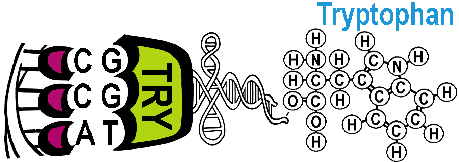 TRY – Tryptophan: An uncharged, Polar molecule, with a water soluble hydrophilic side chain. A Heterocyclic molecule similar to other organic carbon compounds, in this case having a nitrogen atom in it’s rings. Essentially hydrophobic, but less strictly segregated from water owing to the possession of a polar (NH) group, and can participate in hydrogen bonding. Found in blood serum, gastric mucous membranes and especially in brain tissue, a precursor to Serotonin and used as an inhibitory neurotransmitter. Stimulates the smooth muscles, transmission of impulses between nerve cells, and in the regulation of cyclic body processes. Used in treatment of migraine headaches, insomnia and some types of depression. A balance must be maintained with other amino acids through dietary intake, or nutritional conflicts can occur.
TRY – Tryptophan: An uncharged, Polar molecule, with a water soluble hydrophilic side chain. A Heterocyclic molecule similar to other organic carbon compounds, in this case having a nitrogen atom in it’s rings. Essentially hydrophobic, but less strictly segregated from water owing to the possession of a polar (NH) group, and can participate in hydrogen bonding. Found in blood serum, gastric mucous membranes and especially in brain tissue, a precursor to Serotonin and used as an inhibitory neurotransmitter. Stimulates the smooth muscles, transmission of impulses between nerve cells, and in the regulation of cyclic body processes. Used in treatment of migraine headaches, insomnia and some types of depression. A balance must be maintained with other amino acids through dietary intake, or nutritional conflicts can occur.
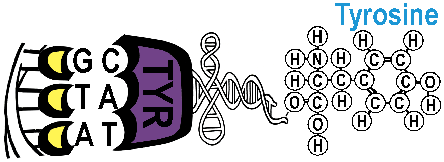 TYR – Tyrosine: This water soluble Polar molecule with a hydrophilic side chain has no electrical charge. A Heterocyclic and Aromatic amino acid, similar to other organic compounds, which combine other elements into the carbon ring. Essentially hydrophobic, but due to the possession of a polar (OH) group, is less strictly segregated from water, and can participate in hydrogen bonding. Direct precursor of adrenaline and thyroid hormones, it helps control depressions and anxiety, and acts as a growth hormone stimulant. Plays an intermediary role in the synthesis of the neurotransmitter Norepinephrine from Phenylalanine. Considered an antioxidant and appetite suppressant.
TYR – Tyrosine: This water soluble Polar molecule with a hydrophilic side chain has no electrical charge. A Heterocyclic and Aromatic amino acid, similar to other organic compounds, which combine other elements into the carbon ring. Essentially hydrophobic, but due to the possession of a polar (OH) group, is less strictly segregated from water, and can participate in hydrogen bonding. Direct precursor of adrenaline and thyroid hormones, it helps control depressions and anxiety, and acts as a growth hormone stimulant. Plays an intermediary role in the synthesis of the neurotransmitter Norepinephrine from Phenylalanine. Considered an antioxidant and appetite suppressant.
 VAL – Valine: This molecule is a Non-Polar amino acid, and thus is not water soluble. It is an aliphatic molecule made up from a short linear chain of carbon atoms. A Very hydrophobic amino acid, tending to be buried in regions from which water is excluded. Nutritional conflicts may occur unless kept in balance with other amino acids through dietary intake. Used to treat severe amino acid deficiencies caused by addictions. One of the branched chain amino acids found in high concentration in muscle tissue.
VAL – Valine: This molecule is a Non-Polar amino acid, and thus is not water soluble. It is an aliphatic molecule made up from a short linear chain of carbon atoms. A Very hydrophobic amino acid, tending to be buried in regions from which water is excluded. Nutritional conflicts may occur unless kept in balance with other amino acids through dietary intake. Used to treat severe amino acid deficiencies caused by addictions. One of the branched chain amino acids found in high concentration in muscle tissue.
The body itself is an information processor. Memory resides not just in brains but in every cell. No wonder genetics bloomed along with information theory. DNA is the quintessential information molecule, the most advanced message processor at the cellular level – an alphabet and a code, 6 billion bits to form a human being.
– James Gleick
